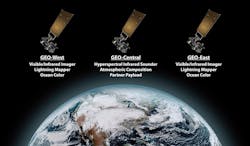NASA selects Ball Aerospace to build instrument for NOAA observation constellation
BROOMFIELD, Colo., - The National Aeronautics and Space Administration (NASA) sought a provider to build a hyperspectral infrared sounding instrument for the National Oceanic and Atmospheric Administration's (NOAA) Geostationary Extended Observations (GeoXO) program. They found their solution from Ball Aerospace in Broomfield, Colorado.
GeoXO will collect data on weather patterns and ocean color, replacing and expanding on NOAA's current Geostationary Operational Environmental Satellite-R Series (GOES-R). The Ball-built GeoXO Sounder (GXS) will provide 3D profiles of the atmosphere over North America in real-time, enhancing numerical weather prediction models to better predict dangerous weather events like tornadoes and hurricanes, and help airlines avoid turbulence and monitor pollutants like ozone and carbon monoxide in the air.
Once launched, GXS will be the first hyperspectral infrared sounder flown by the United States in geostationary orbit.
"This long-awaited instrument will serve as an essential tool in improving the safety of our communities, the health of our residents and our understanding of extreme weather," said Dr. Alberto Conti, vice president and general manager, Civil Space, Ball Aerospace. "GXS will allow forecasters to track tornadoes and floods as they develop to provide earlier warnings to residents, and the higher resolution and frequency of atmospheric measurements will contribute new insights about the way weather patterns form. We're excited to continue our partnerships with NOAA and NASA on GXS and to support this important mission."
In 2021, NASA selected Ball Aerospace to conduct a Phase A study for GXS, which was used to set performance requirements for the instrument. Ball was also selected to conduct studies for the Atmospheric Composition (ACX) and Ocean Color (OCX) instruments that will fly in the new constellation. GeoXO is expected to launch in the early 2030s and continue operating through 2055.
